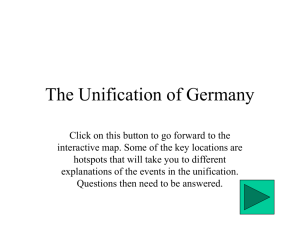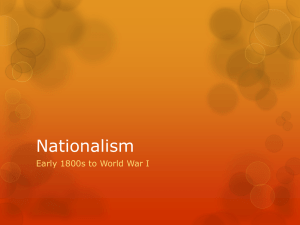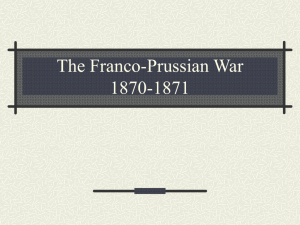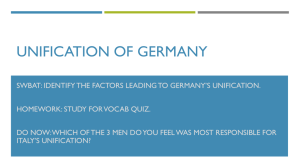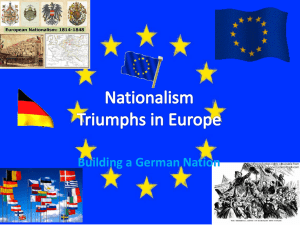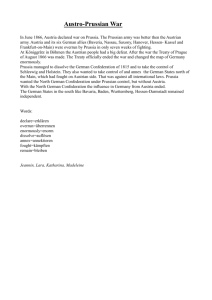0470/2 HISTORY PAPER 2 OCTOBER/NOVEMBER SESSION 2002
advertisement
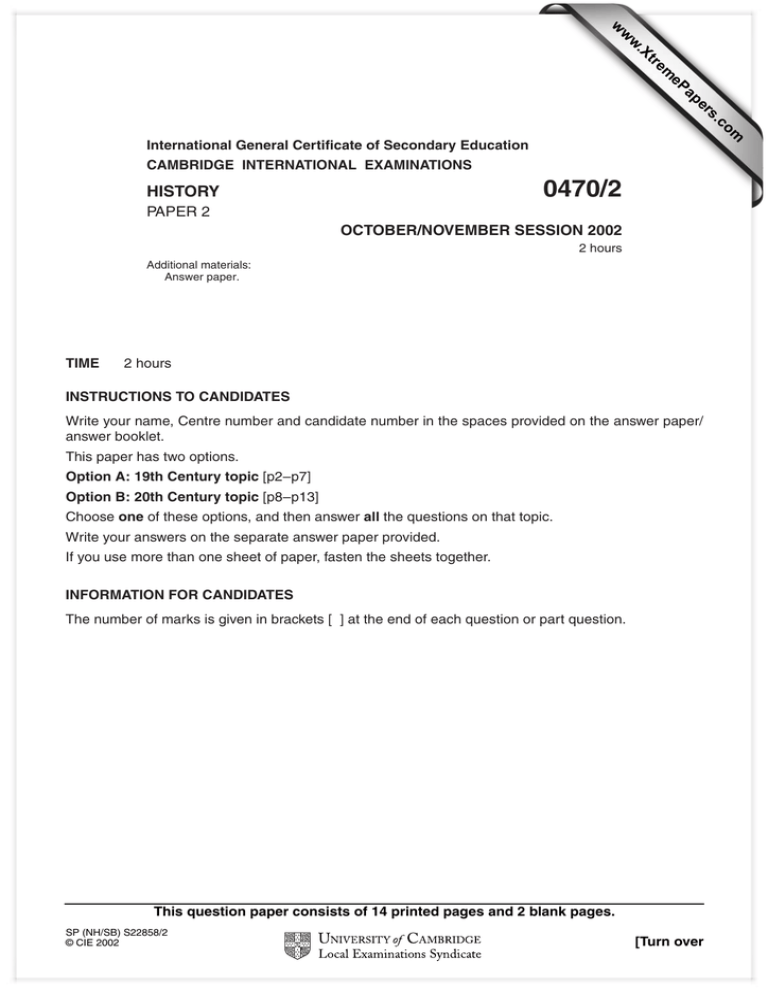
w w ap eP m e tr .X w om .c s er International General Certificate of Secondary Education CAMBRIDGE INTERNATIONAL EXAMINATIONS 0470/2 HISTORY PAPER 2 OCTOBER/NOVEMBER SESSION 2002 2 hours Additional materials: Answer paper. TIME 2 hours INSTRUCTIONS TO CANDIDATES Write your name, Centre number and candidate number in the spaces provided on the answer paper/ answer booklet. This paper has two options. Option A: 19th Century topic [p2–p7] Option B: 20th Century topic [p8–p13] Choose one of these options, and then answer all the questions on that topic. Write your answers on the separate answer paper provided. If you use more than one sheet of paper, fasten the sheets together. INFORMATION FOR CANDIDATES The number of marks is given in brackets [ ] at the end of each question or part question. This question paper consists of 14 printed pages and 2 blank pages. SP (NH/SB) S22858/2 © CIE 2002 [Turn over 2 Option A: 19th Century Topic HOW FAR WAS BISMARCK RESPONSIBLE FOR THE UNIFICATION OF GERMANY? Study the Background Information and the sources carefully, and then answer all the questions. Background Information On 18 January 1871, at Versailles near Paris, the new united German Empire was proclaimed. Historians disagree about the process by which Germany came to be united. Some have argued that not only was Bismarck largely responsible for bringing about unification, but that this was his overall plan which he followed step by step even before he became Prime Minister of Prussia in 1862. Others have argued either that Bismarck had no plan and merely reacted to events as they happened, or that there were many other factors more important than Bismarck working for German unity. SOURCE A Many modern historians support the view that from the 1830s onwards Prussia was using the Zollverein to achieve ‘a Prussian solution to the German question’. The argument is that those German states who found financial advantage in an economic union under Prussian leadership might be expected to take a favourable view of similar arrangements in a political union. The Zollverein was a force for unity in the 1840s and therefore a focal point for nationalist sentiments. As a result, Prussia, despite not having liberal sympathies, came to be regarded by many as the natural leader of a united Germany. From a history book published in 1986. SOURCE B Few would dispute that the Zollverein was a powerful factor in the eventual exclusion of Austria from a united Germany dominated by Prussia. It is also by no means clear that the Zollverein could have achieved German unity unaided by other factors. The lesser German states clung to their independence. In 1866 the South German States were not prevented by their membership of the Zollverein from allying with Austria against Prussia. From a different history book published in 1986. SOURCE C The demands which have been expressed loudly throughout our fatherland, and the past calls of the state governments have led, in this great hour, to this great Assembly, such as has never been seen in our history. The best of our old political life is revealed in the basic principles of this Assembly, which has been greeted with joy and confidence by the entire German people. It is a great new achievement – the German parliament. The German governments and the Bund are united with the German people in their similar love for our great fatherland. A message from the Bund, at the opening of the German National Assembly, 18 May 1848. 0470/2 O/N/02 3 SOURCE D Bismarck might be described as firstly Prussian, secondly through and through Prussian and thirdly German through Prussian. He has a great contempt of public opinion and of German liberalism. I think that nothing would persuade him against the aim of an expansion of Prussian territory, which is the object of his life. A representative of the British government in Prussia writing to the British Foreign Secretary, May 1862. SOURCE E A British cartoon published in 1867. France is saying to Prussia: ‘Now you are big enough. You must not get any bigger. I’m telling you this for your health.’ 0470/2 O/N/02 [Turn over 4 SOURCE F Germany doesn’t look to Prussia’s liberalism, but to its power: Bavaria, Württemberg, Baden can indulge in liberalism, but no one will expect them to undertake Prussia’s role; Prussia must gather her strength in readiness for the favourable moment, which has already been missed several times; Prussia’s boundaries are not favourable to a healthy political life; the great decisions of the time will be made not by means of speeches and majority verdicts – that was the great mistake of 1848 and 1849 – but by iron and blood. Bismarck speaking to the Prussian Landtag in September 1862. SOURCE G When the army has been brought to such a state as to command respect, then I shall take the first opportunity to declare war with Austria, tear apart the German Confederation, bring the middle and smaller states under our control and give Germany a national union under the leadership of Prussia. Bismarck speaking to a British politician in 1862. SOURCE H It seems to me that two facts have tended to guide German policy into new paths, to modify the position of Bavaria, and to unite the country more closely to Germany. One of these facts is the awakened spirit of nationalism throughout the German people, and the other is the changed status of Austria and Prussia. The German Empire is complete not because military alliance means giving in to the power of the stronger ally, but because German nationalism has become a power in this war and a force to which preference for traditional institutions must give way. From a speech by Prince Hohenlohe to the Upper House of Bavaria, in 1870 just after the end of the Franco-Prussian War. 0470/2 O/N/02 5 SOURCE I A painting entitled ‘The Proclamation of the German Empire’. This is the third version of this painting and was painted in 1885 to celebrate Bismarck’s seventieth birthday. The original version was painted in 1871 and showed the occasion as dull, with Bismarck in a less important position. In this version, the artist has placed Bismarck at the centre (in white). 0470/2 O/N/02 [Turn over 6 SOURCE J In later life Bismarck claimed that he had always intended to fight Austria and to unify Germany, and this version was generally accepted by his admirers and by most historians. In reality, Bismarck’s greatness lay not in mastering events, but in going with events so as to seem to master them. From a British history book published in 1945. 0470/2 O/N/02 7 Now answer all the following questions. You may use any of the sources to help you answer the questions, in addition to those sources which you are told to use. In answering the questions you should use your knowledge of the topic to help you interpret and evaluate the sources. 1 Study Sources A and B. How far do Sources A and B agree? Use the sources to explain your answer. 2 [6] Study Sources C and D. Would Bismarck have approved of the message in Source C? Use the sources and your knowledge to explain your answer. [8] 3 Study Source E. What is the message of this cartoon? Use the cartoon and your knowledge to explain your answer. [7] 4 Study Sources F, G and H. How far do Sources F and G prove that Prince Hohenlohe (in Source H) was wrong? Use the sources and your knowledge to explain your answer. [9] 5 Study Source I. Has this source any value for the historian studying the unification of Germany? Use the source and your knowledge to explain your answer. [8] 6 Study all the sources. ‘Bismarck planned, and was largely responsible for, the unification of Germany in 1871.’ How far do the sources in this paper support this view? Use the sources to explain your answer. [12] 0470/2 O/N/02 [Turn over 8 Option B: 20th Century Topic WHY DID THE SOVIET UNION INVADE HUNGARY IN 1956? Study the Background Information and the sources carefully, and then answer all the questions. Background Information In 1953 Stalin died. He had kept tight control over the Communist countries in Eastern Europe. After his death it appeared that Soviet control might be slipping. In June 1956 there were strikes and demonstrations in Poland against the Soviet Union. Khrushchev, the new Soviet leader, sent in troops and tanks, but also agreed to allow a moderate and popular leader to stay in power. Hungary was the next country to cause problems for Khrushchev. In June 1953 Nagy had replaced the Stalinist Rakosi as Prime Minister. Nagy started to introduce reforms. This worried the Soviet Union and in 1955 Nagy was removed from office. However, he remained popular and in October 1956 antiSoviet demonstrations broke out, leading to Nagy’s reappointment. When Nagy announced further reforms, Khrushchev sent in troops and tanks. Heavy fighting followed and Nagy’s government was overthrown early in November. Why did Khrushchev invade Hungary in 1956? 0470/2 O/N/02 9 SOURCE A A British cartoon published in October 1956. The man in the centre is Khrushchev. SOURCE B In 1956 a bloody struggle broke out in Budapest. Imre Nagy used deceit and intimidation to draw people into mutiny. He shoved prominent citizens in front of microphones and forced them to support his leadership and to denounce the Rakosi regime. Communist Party members were being hunted in the streets and strung up from lampposts. The NATO countries were already adding fuel to the flames of the civil war in the hope that the Communist government would be overthrown and capitalism would be restored in Hungary. Imre Nagy issued a demand that we pull all Soviet troops out of Hungary. Nagy spoke only for himself and his small number of supporters. We quickly determined that the uprising was without support from the workers, the peasants, and the intelligentsia of the country as a whole. From Khrushchev’s memoirs published in 1971. 0470/2 O/N/02 [Turn over 10 SOURCE C We agreed with the new leadership of Hungary that Nagy’s mutiny had been caused by Stalin’s abuse of power and that the seeds of discontent had been sown in Hungary by Stalin’s advisor, Rakosi. In other words, Nagy’s counter-revolution was another consequence of Stalin’s sick character. From Khrushchev’s memoirs. This extract comes just 11 pages after the extract in Source B. SOURCE D Stalin originated the concept of ‘enemy of the people’. This term made possible the use of the most cruel oppression. Stalin was sickly suspicious. Everywhere he saw ‘enemies’. Stalin was also responsible for the development of the conflict with Yugoslavia. From Khrushchev’s speech, to the Twentieth Congress of the Communist Party, in Moscow in February 1956. SOURCE E We have almost no weapons, no heavy guns of any kind. People are running up to the tanks, throwing in hand grenades and closing the drivers’ windows. The Hungarian people are not afraid of death. It is only a pity that we cannot last longer. Now the firing is starting again. The tanks are coming nearer and nearer. You can’t let people attack tanks with their bare hands. What is the United Nations doing? A telex message sent in October 1956 by the Hungarian rebels. SOURCE F In Hungary thousands of people have obtained arms by disarming Soviet soldiers and militia men. Soldiers have been making friends with the bitter and dissatisfied masses. The authorities are paralysed, unable to stop the bloody events. From a report in a Yugoslav newspaper, October 1956. 0470/2 O/N/02 11 SOURCE G A cartoon from a British magazine, November 1956. The teacher, representing the United Nations, is punishing Israel, a small nation, for invading Egypt. SOURCE H We could not overlook the fact that Hungary is a neighbour of the Soviet Union. A victory of the reactionary forces would have converted that country into a new jumping-off ground for an aggressive war not only against the Soviet Union, but also against the other countries of Eastern Europe. The Soviet Foreign Minister explaining Soviet actions in Hungary to the United Nations, 19 November 1956. 0470/2 O/N/02 [Turn over 12 SOURCE I A socialist state could not remain a silent observer of the bloody reign of Fascist reaction in the People’s Democratic Hungary. When everything settles down in Hungary, and life becomes normal again, the Hungarian working class, peasantry and intelligentsia will understand our actions better and judge them right. From an article in Pravda, the Soviet Government newspaper, 23 November 1956. SOURCE J The Soviet Union bases its policy towards other countries, big or small, on the principle of peaceful coexistence. We believe in equality, non-interference and respect for national independence. The Soviet Union rejects aggression and believes that any invasion of another state is not to be permitted. From a speech by Khrushchev when he visited Yugoslavia in 1955. 0470/2 O/N/02 13 Now answer all the following questions. You may use any of the sources to help you answer the questions, in addition to those sources which you are told to use. In answering the questions you should use your knowledge of the topic to help you interpret and evaluate the sources. 1 Study Source A. What is the message of this cartoon? Use the cartoon and your knowledge to explain your answer. [6] 2 Study Sources B, C and D. Does Source D prove that Khrushchev was saying what he really thought in Source C and was lying in Source B? Use the sources and your knowledge to explain your answer. [9] 3 Study Sources E and F. Explain the differences between these two accounts. Use the sources and your knowledge to explain your answer. [7] 4 Study Sources G and H. How useful are these sources as evidence for why the Soviet Union invaded Hungary in October 1956? Use the sources and your knowledge to explain your answer. [8] 5 Study Sources I and J. Does Source I show that the promises given by the Soviet Union in Source J were meaningless? Use the sources and your knowledge to explain your answer. [8] 6 Study all the sources. How far do the sources in this paper support the view that the Soviet Union invaded Hungary in 1956 to help the Hungarian people? Use the sources and your knowledge to explain your answer. [12] 0470/2 O/N/02 14 BLANK PAGE 0470/2 O/N/02 15 BLANK PAGE 0470/2 O/N/02 16 Copyright Acknowledgements: Option A: Source A Option A: Source B Option A: Source J Option A: Source K Option A: Source A Option B: Source B Option B: Source C Option B: Source D Option B: Source E Option B: Source F Option B: Source H Option B: Source I Option B: Source J Andrina Styles. The Unification of Germany 1819 – 90. Published by Hodder and Stoughton. 1986. D G Williamson. Bismarck and Germany 1862 – 1890. Published by Hodder and Stoughton. 1986. William Simpson. The Second Reich. © A.K.G. London Ltd. A J P Taylor. The Course of German History. Published by Hamish Hamilton. Punch Magazine. 1956 Khrushchev. Khrushchev Remembers. Published by Andre Deutsch. Khrushchev. Khrushchev Remembers. Published by Andre Deutsch. John Caver. The USSR, 1945 – 1990. Hodder and Stoughton Ben Walsh. Modern World History. Published by John Murray. Ben Walsh. Modern World History. Published by John Murray. Tony McAleavy. Modern World History. 1996. © Cambridge University Press. Extract from International Relations by Tony Rea and John Wright, by permission of Oxford University Press. Tony McAleavy. Modern World History. 1996. © Cambridge University Press. Cambridge International Examinations has made every effort to trace copyright holders, but if we have inadvertently overlooked any we will be pleased to make the necessary arrangements at the first opportunity. 0470/2 O/N/02
